Bearing Elements
Bearing Element General Description & Quick Guide
FlowSimulator supports three category of bearings which includes Journal Bearing, Roller bearing & Ball bearing components. Journal bearing has 4 subtypes namely Journal bearing: Bore, Journal bearing: Grove, Journal Bearing: Pocket, Journal bearing: special pocket. All the bearing elements can be used only in Incompressible (e.g. hydraulic and non-hydraulic systems) analysis.

Journal Bearing with Bore:
The component simulates a steadily loaded rotating or pivot bearing in a typical engine lubrication system. Its main use is as a discharge element, which simulates lubricant fed to the bearing by a bore or bores, located at various positions relative to the applied loading. The model permits a choice of one or two bores, each of which is located at a user-defined angle to the displacement of the bearing caused by the load.
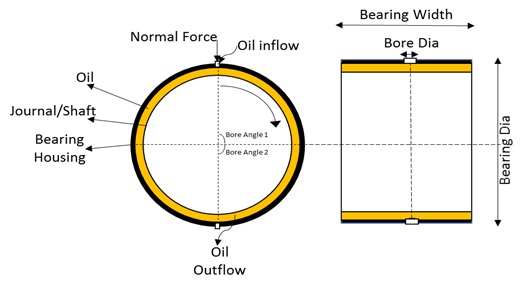
Fig: Journal Bearing with Bore
Journal Bearing with Groove:
The component simulates a steadily loaded rotating or pivot bearing in a typical engine lubrication system. Its main use is as a discharge element, which simulates lubricant fed to the bearing by a circumferential groove within the bearing shell. The model permits a choice of angular length and position of the groove.
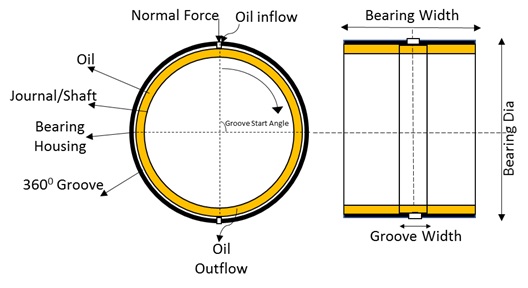
Fig: Journal Bearing with Groove
Journal Bearing with Pocket:
The component simulates a steadily loaded rotating or pivot bearing in a typical engine lubrication system. Its prime use is as a discharge element, which simulates a lubricant feed to the bearing by a pocket within the bearing shell. Pockets are modelled using equation from “Plain bearings - Hydrodynamic plain journal bearings under steady-state conditions - Part 1: Calculation of circular cylindrical bearings” DIN 31652. The model permits a choice of one or two pockets, each of which is located at a user-defined angle to the displacement of the bearing caused by the load.
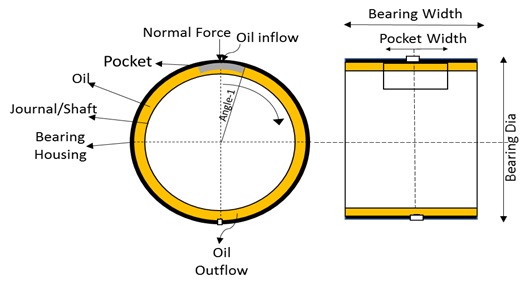
Fig: Journal Bearing with Pocket
Journal Bearing with Special Pocket:
The component simulates a steadily loaded rotating bearing or pivot bearing in a typical engine lubrication system. It can be used as a discharge element, which simulates lubricant fed to the bearing by a special pocket in the bearing shell. The model permits a choice between one and two special pockets at ±90° to the load direction.
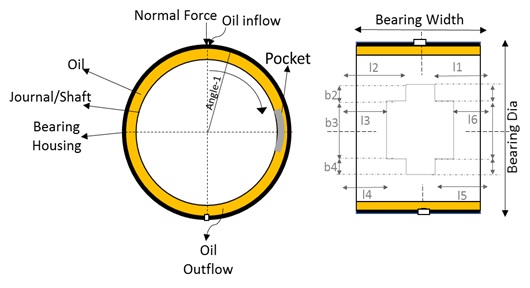
Fig: Journal Bearing with Special Pocket
Bearing Element Inputs
Table of the inputs for the Bearing Element.
| Element Specific Journal Bearing: Bore Input variables | ||||||||
| Index | Field | Description | ||||||
| 1 | Rotational Speed | Rotational speed of the bearing | ||||||
| 2 | Normal Force | The reaction force generated by the load of the bearing. It acts perpendicular to the shaft | ||||||
| 3 | Bearing Diameter | The diameter of the bearing | ||||||
| 4 | Bearing Width | The width of the bearing | ||||||
| 5 | Relative Clearance |
Average clearance between the shell of the bearing and the shaft Relative Clearance = (Total Clearance) / (Bearing Diameter) |
||||||
| 6 | Bore Diameter | The diameter of the bore in the bearing | ||||||
| 7 | Bore Angle 1 & Bore Angle 2 |
The bore(s) angle(s) to the displacement of the bearing caused by the load. If both bore angles are set, two bores are modelled
|
||||||
| 8 | Bearing Friction Heating |
Used to determine if frictional heating is to be modelled. There are two available options:
|
||||||
| 9 | Rotational or Pivot Bearing |
Used to select the type of bearing to be modelled. There are two available options:
|
||||||
| Element Specific Journal Bearing: Groove Input variables | ||||||||
| Index | Field | Description | ||||||
| 1 | Rotational Speed | Rotational speed of the bearing | ||||||
| 2 | Normal Force | The reaction force generated by the load of the bearing. It acts perpendicular to the shaft | ||||||
| 3 | Bearing Diameter | The diameter of the bearing | ||||||
| 4 | Bearing Width | The width of the bearing | ||||||
| 5 | Relative Clearance |
Average clearance between the shell of the bearing and the shaft Relative Clearance = (Total Clearance) / (Bearing Diameter) |
||||||
| 6 | Width of Groove | Width of the groove in the bearing | ||||||
| 7 | Grove Start Angle & Groove Angular Length |
The angle at which the groove starts. This value is positive in the direction of rotation of the shaft relative to the housing and is measured from the line along which the journal is displaced by the load. The arc length of the groove expressed as the angle it subtends about the rotational axis of the bearing |
||||||
| 8 | Bearing Friction Heating |
Used to determine if frictional heating is to be modelled. There are two available options:
|
||||||
| 9 | Rotational or Pivot Bearing |
Used to select the type of bearing to be modelled. There are two available options:
|
||||||
| Element Specific Journal Bearing: Pocket Input variables | ||||||||
| Index | Field | Description | ||||||
| 1 | Rotational Speed | Rotational speed of the bearing | ||||||
| 2 | Normal Force | The reaction force generated by the load of the bearing. It acts perpendicular to the shaft | ||||||
| 3 | Bearing Diameter | The diameter of the bearing | ||||||
| 4 | Bearing Width | The width of the bearing | ||||||
| 5 | Relative Clearance |
Average clearance between the shell of the bearing and the shaft Relative Clearance = (Total Clearance) / (Bearing Diameter) |
||||||
| 6 | Pocket Width | width of the bearing pocket. | ||||||
| 7 | Pocket Angular Length | The Pocket angular length of the bearing | ||||||
| 8 |
Pocket Angle 1 & Pocket Angle 2 |
The pocket(s) angle(s) measured from the line along which the journal is displaced by the load. If both Pocket Angles to load are set, two pockets are modelled
|
||||||
| 9 | Bearing Friction Heating |
Used to determine if frictional heating is to be modelled. There are two available options:
|
||||||
| 10 | Rotational or Pivot Bearing |
Used to select the type of bearing to be modelled. There are two available options:
|
||||||
| Element Specific Journal Bearing: Special Pocket Input variables | ||||||||
| Index | Field | Description | ||||||
| 1 | Rotational Speed | Rotational speed of the bearing | ||||||
| 2 | Normal Force | The reaction force generated by the load of the bearing. It acts perpendicular to the shaft | ||||||
| 3 | Bearing Diameter | The diameter of the bearing | ||||||
| 4 | Bearing Width | The width of the bearing | ||||||
| 5 | Relative Clearance |
Average clearance between the shell of the bearing and the shaft Relative Clearance = (Total Clearance) / (Bearing Diameter) |
||||||
| 6 | BbyL ratio |
Used to set the bearing geometry (see figure in overview topic). It is the sum of all the geometries shown in the figure:
|
||||||
| 7 | Number of Pockets |
Used to set the number of pockets in the bearing. There are two available options:
|
||||||
| 8 | Bearing Friction Heating |
Used to determine if frictional heating is to be modelled. There are two available options:
|
||||||
| 9 | Rotational or Pivot Bearing |
Used to select the type of bearing to be modelled. There are two available options:
|
||||||
Bearing Element Theory Manual
Bearing Calculation procedures:

Volumetric Flow Caused by the Supply Oil Pressure
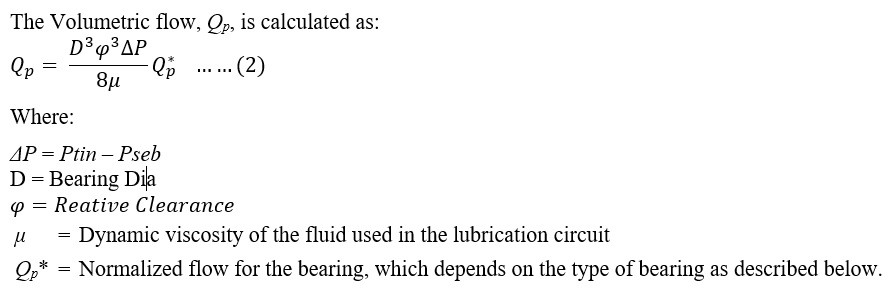
Journal bearing with Bore:
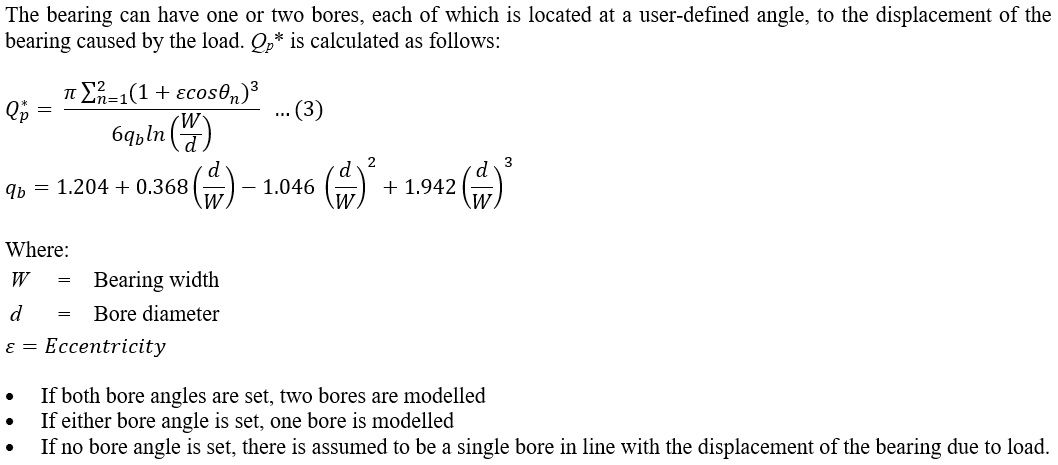
Journal bearing with Groove:
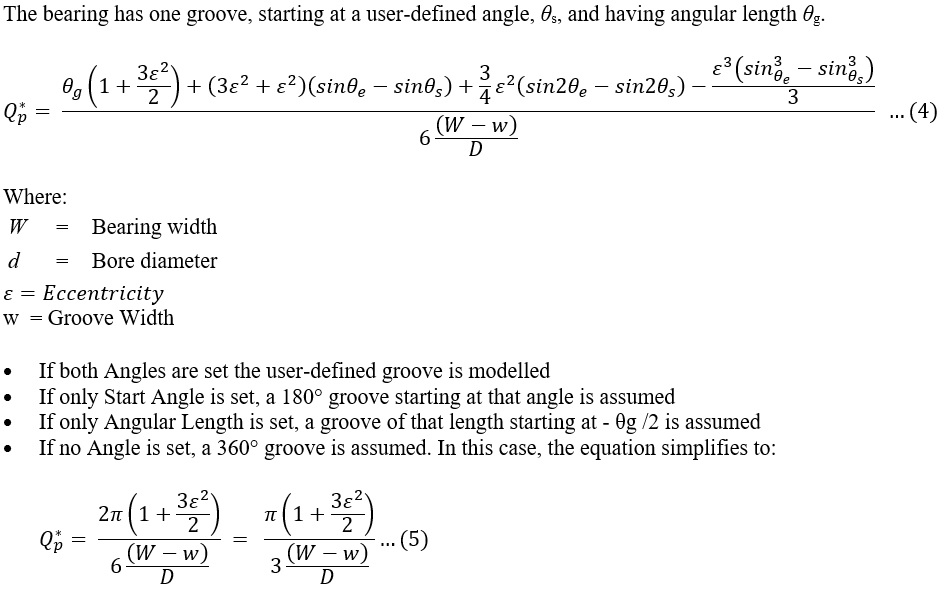
Journal Bearing with Pocket
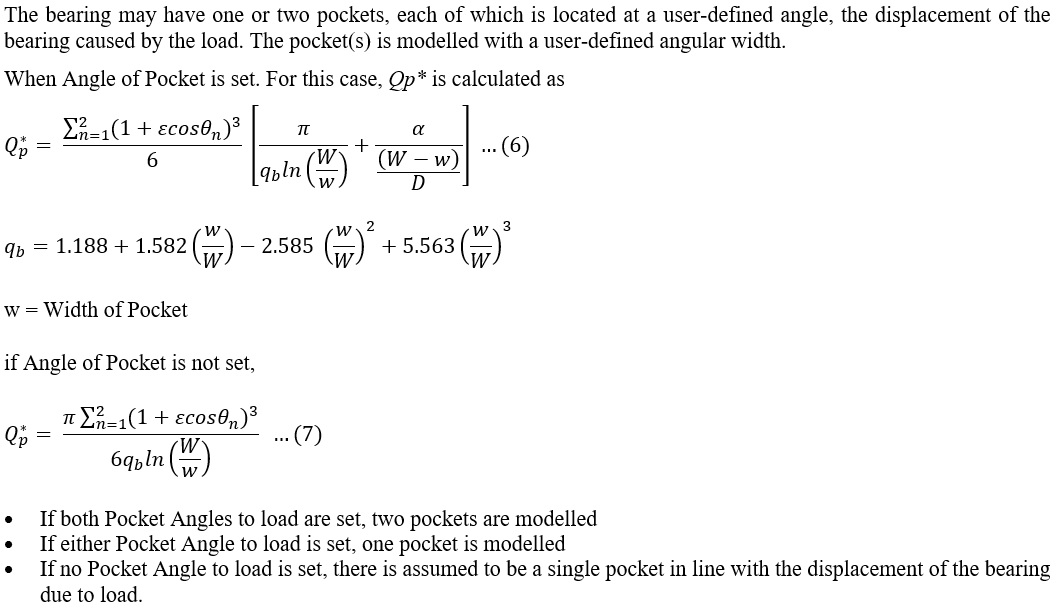
Journal Bearing with Special Pocket:
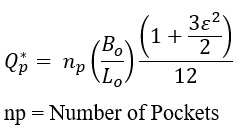
Volumetric Flow Caused by Shaft Motion
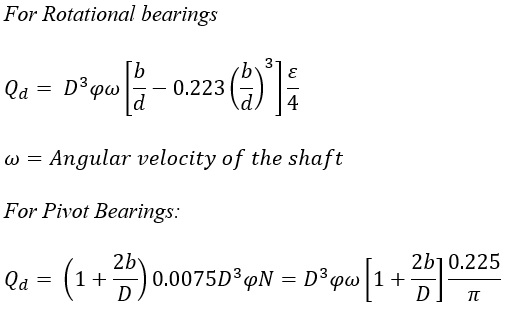
Exit Oil Temperature Prediction
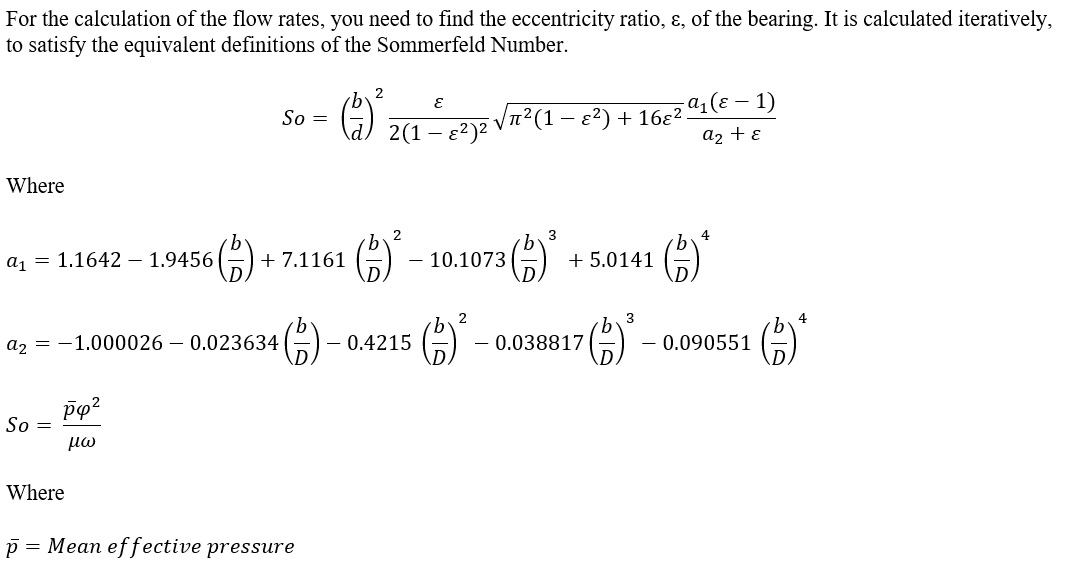
Coefficient of Friction:
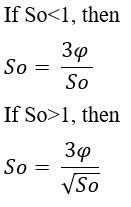
Friction Power:
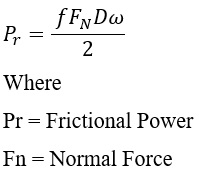
Exit Oil Temperature:

Bearing Element Outputs
The following listing provides details about conventional orifice output variables.
| Name | Description | Units |
|---|---|---|
| SUBTYPE |
Bearing Subtype (An echo of the user input) |
(None) |
| BEARING_TYPE |
Type of Bearing (Pivot or Rotating) (An echo of the user input) |
(None) |
| SPEED |
Rotational Speed (An echo of the user input) |
RPM |
| NORMAL_FORCE |
Normal Force (An echo of the user input) |
Lbf, N |
| BEARING_DIA |
Diameter of Bearing (An echo of the user input) |
in, mm |
| BEARING_WIDTH |
Width of Bearing (An echo of the user input) |
in, mm |
| DQ_IN |
Portion of Ustrm Chamb. Dyn. Head Lost (Usually an echo of the user input unless modified inside Flow Simulator.) |
(None) |
| ELEMENT_THETA |
Tangential Angle (Usually an echo of the user input but converted to radians.) |
radians |
| ELEMENT_PHI |
Radial Angle (Usually an echo of the user input but converted to radians.) |
radians |
| Flowrate_DUE_TO_ROTATION | Volumetric Flowrate due to Rotation effects | GPM, m3/s |
| Flowrate_DUE_TO_DELTAP | Volumetric Flowrate due to pressure drop across bearings | GPM, m3/s |
| REL_CLEARANCE |
Relative Clearance (Usually an echo of the user input) |
in, mm |
| MIN_CLEARANCE | Minimum Clearance | in, mm |
| SOMMERFIELD_NUMBER | Somerfield Number | (None) |
| FRICTION_POWER_LOSS | Friction Power Loss | HP, W |
| BEARING_TEMPERATURE_RISE | Temperature Rise across bearings | deg F, deg K |
| BEARING_TEMPERATURE | Bearing Temperature | deg F, deg K |
References
- Hydrodynamic plain journal bearings under steady- state conditions: Circular cylindrical bearings -Part 1: Calculation procedure, ISO 7902-1:2013
- Hydrodynamic plain journal bearings under steady-state conditions, DIN 31652